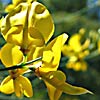Spanish Broom (Rush Broom) is a branched and dense shrub. It reaches a height of 1-2 meters, and sometimes even up to 4 meters. Its branches (trunks) are gray, and somewhat scabrous. The young stems are ephemeral: green, smooth, with longitudinal grooves. The stomata are found within these grooves, protected against rapid evaporation. The leaves appear in the spring but do not persist for long. They are entire, lanceolate, 20-40 mm long. Their color turns silvery because of a sparse cover of soft hairs.
Spartium junceum blooms all at once, with a rich efflorescence, from April to June. The flowers are arranged in a raceme-like inflorescence of 10-30 flowers. The flower is pea shaped, lemon-yellow, fragrant, and large (2-3 cm). The calyx is scarious. The standard is wide and prominent. The flower has 10 stamens, with fused filaments. The ovary is superior. Pressing on the base of the keel causes the release of the stamens by tearing the fusion between the two petals that compose the keel. A kind of explosion is created, and the pollen disperses in the form of a small yellow cloud. The flower is pollinated by large bees, such as Xylocopinae. The fruit is an elongated and compressed legumen. It is 4-7 cm long and contains numerous seeds. Upon ripening, the color of the legumen changes to dark brown. The seeds are dispersed when the legumen suddenly opens into two curled valves and the seeds are thrown into the surroundings.
Spartium junceum is a protected plant. It is common in the Mediterranean Maqui in the north of Israel, dominates in places that were damaged by bulldozers or fire, and is planted in gardens and along roads as an ornamental plant. Its global distribution is Mediterranean.
The seeds, leaves and stems contain toxic materials. Eating parts of the plant may cause weakness, changes in heart rate, decrease in blood pressure and shortness of breath.
Written by Erga Aloni







